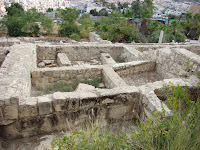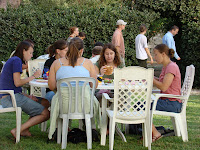Today was an amazing trek through the heartland of Israel. We started out in Jerusalem and traveled down to the Wadi
Qilt, that drains the east side of the Mt of Olives and climbed down into the Wadi (for those who don't know a wadi is just what they call the drainage valleys of the mountains) and then walked/climbed our way to Jericho in the Jordan River Valley. We took a bus from there up to the Benjamin Plateau and climbed up to
Nabi Samwill which is the highest point in the plateau in the midst of old Gideon. We then traveled down to the coastal plains (by way of the Beth-
Horan ridge route which was important all throughout the OT) of
Gezer and watched the sun set over the
Cis-Jordan mountains (the high country of Israel).

As we climbed down into the Wadi there was an amazing monastery at the bottom with small rock houses built into the cliffs almost the entire way down to Jericho.

(aqueduct)

(wadi bottom)
Also Herod built a aqueduct that runs from the Jerusalem area and runs the length of the wadi all the way to his palace at the edge of the Jericho plain. Around the aqueduct is the only green in the wadi except spare areas in the very bottom where enough dew settles to provide water for plant life. It would have been a hard life as monks in the wadi. There is little water, no place to grow anything even if there was water, and only lizards to eat.


You only had small rock caves for shelter, and it gets pretty cold in the winter, enough that it snows in Jerusalem from time to time.

(looking out the wadi at Jericho)
As we exited the wadi into the plains of Jericho it was a welcome site of green and life. Right at the edge of the plain was a Palace complex built by Herod complete with pools,

(banquet hall

(bath complex)
bath houses, gardens, and two large banquet halls. From there you could see almost the entire Jordan Valley, from the Dead Sea in the south, to the Trans-Jordan mountains in the east, and several miles up the Jordan/Rift Valley. Would walked down and stood on the top of the OT Jericho tell that is still being excavated and saw the oldest stone structure on the earth that has been found. It was built around 2500 BC and it is the tower and section of the wall surrounding the city known to exist of Jericho.
We then got on the
bus and headed up into the Central Benjamin Plateau where Saul was and the base of his kingdom was formed, and his hometown of
Gibeah was. From the high point on the plateau of
Nabi Samwill you could see the entire plateau, all the way to Jerusalem, the Dead Sea, and the Mediterranean Sea. It was an impressive view and really brought home the importance of it as a strategic location. It also overlooked the two main road ways of the Israel high country, the Central Ridge Route and the Beth
Horan ridge route. Almost 60% of all the stories of the OT take place in this Plateau so you can really begin to understand its importance. Also being the flattest portion of the high country it is the most cultivated area of the hill country and so it provided the majority of the crops for the entire nation of Israel.

(Ruins of
Gibeon around
Nabi Samwill)
We then descended down into the Coastal plains to
Gezer the doorway into the hill country, or looked at from the other way the central hill countries main way down to the sea. Right on the foothills before the coastal plains
Gezer held the Beth
Horan ridge route either for or against those in the central hill country. It is beside the
Aijalon Valley and was the place of many battles and conquest by Israel, Egypt, Philistines, Babylonians, and Assyrians.

(
Solomonic 6 chamber gate at
Gezer)
Gezer played a major roll in the history if Israel, and later Judah. As we sat and watched the sun set over the mountains we read through Joshua and the battle that took place in the hill country and out onto the plains were Joshua called to God to have the sun and moon stand still over the valley of
Aijalon so he could complete his victory.

(Large standing stones in
Gezer)
It was a great end to a long day.

(Moon over the
Aijalon Valley)

















































